30 Best Bathroom Plants: Complete List with Names and Photos
If you are wondering what species will survive in your bathroom, consider the following factors: temperature, light, and humidity. They have a crucial influence on your bathroom plants.
 Indoor Plants Selection & Care
Indoor Plants Selection & Care Bathroom plants requirements and recommendations
Before you start growing plants, you should pay special attention to the conditions in the bathroom. But remember that in a guest bathroom or powder room, the conditions may be relatively dry most of the time and darker than in a family bathroom. Not all houseplants can endure a stay in such an environment without stress.
Both too-cold and too-warm rooms are not recommended for growing indoor plants. If your bathroom experiences significant fluctuations in temperature, remember that it can also harm the plants.
Not all plants prefer high air humidity. These include cacti and succulents. At high air humidity, fungal diseases, such as powdery mildew, can develop in plants. One way to eliminate excess moisture in a room is to ventilate it. In addition, many bathrooms have radiators and pipes that heat the surroundings, quickly removing water in the air.
The ideal solution for growing bathroom plants is the availability of a window. If there is no window, the answer may be lamps that emit direct sunlight. Another option is to select shade-loving plants and take them out to a sunny room at least one day a week. However, only some have the time and willingness to do so.
Ranking of the best bathroom plants
-
King Begonia

King begonia (Begonia rex) King begonia comes from tropical, humid regions of South America and Asia. In container cultivation, it grows up to 30 cm in height.
Too intense bright light causes the begonia leaves to turn pale. On the other hand, too much shading will cause poor coloration of the leaves. Therefore, begonia is best grown in partial shade or with slight sun exposure. With inadequate position, begonia becomes susceptible to fungal diseases, particularly powdery mildew. Reacts by shedding leaves when the place is too cold.
Recommended varieties of the king begonia Variety name Appearance Emerald princess Green leaves with white veins Red baron Purple-red leaves with a lighter pink or white center, older leaves dark pink in the center Lucerna Deep, bottle green in color and covered with regular, contrasting white dots -
Cast iron plant

The cast iron plant flowers The cast iron plant is an evergreen plant that occurs naturally in the dark forests of China and Japan. Due to its low requirements, it is considered one of the least demanding potted plants. The plant is ornamental with lush dark green leaves. Inconspicuous sheds of cast iron plants grow just above the earth's surface. However, cast iron plant grown in containers rarely blooms.

The cast iron plant leaves The cut cast iron plant leaves are durable and successfully used in floristry. Only root rot and plant dieback is caused by too high substrate moisture. The plant is resistant to diseases and pests.
Recommended varieties of the cast iron plant Variety name Appearance Variegata With variegated leaves -
Venus fly trap flower

The Venus flytrap flower (Dionaea muscipula) The Venus flytrap flower is an inconspicuous, carnivorous plant native to the wetlands of North and South Carolina. It has distinctive trap leaves consisting of two sharp-edged lobes covered with hairs that close when an insect or other arthropod touches. Once closed, the venus flytrap flower secretes digestive juice that decomposes the victim's flesh, and the plant receives nourishment.
The venus flytrap flower is an excellent choice for bathrooms as it thrives in high-humidity environments and even wet soil, making it ideal for the humid conditions often found in bathrooms. It also requires minimal maintenance, making Dionaea muscipula the perfect solution for busy people needing an easy-to-maintain plant. The Venus flytrap flower is also excellent for interior decoration with bright, indirect light. The light green color of this unique plant is a great accent to any room.
-
Maidenhair fern

The maidenhearn fern (Adiantum capillus-veneris) The maidenhair fern is a bathroom plant worth considering. It is an attractive fern species, with wispy light green fronds reaching for the sky. Not only does it add an element of beauty and greenery to your bathroom, but it can also help to increase the humidity within the environment. Maidenhair fern is ideal for environments where air dryness or heating tends to be a problem, such as bathroom and kitchen areas.
Additionally, the maidenhair fern is particularly low-maintenance due to its preference for partial shade and bright, indirect light, making it perfect for bathroom settings without windows or natural light sources. If you are looking for a bathroom plant to bring some life, peace, and comfort into the area, then the maidenhair fern is most certainly worth considering.
-
Peacock plant
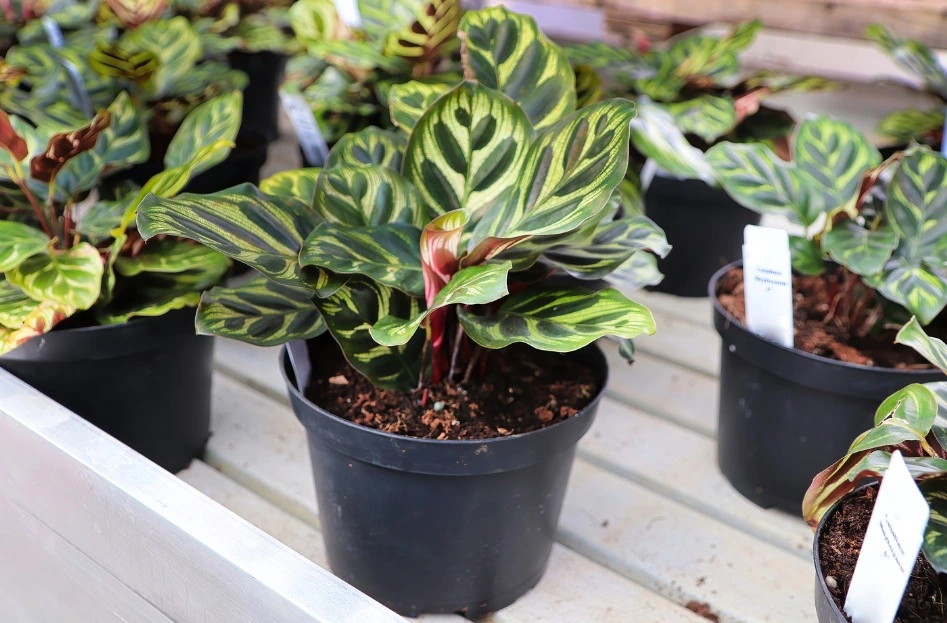
The peacock plant (Calathea makoyana) Peacock plants called cathedral windows are becoming popular bathroom plants due to their ability to thrive in a humid environment. They love bright, indirect bathroom lighting and require frequent water spraying for optimal growth. It makes them a good choice for bathroom conditions.
The peacock plant also purifies the air by removing toxins such as xylene and benzene from the bathroom atmosphere, making bathroom use more enjoyable for everyone. In addition, their beautiful leaves with large green and white zebra stripes will enliven and color small bathrooms.
-
Dracaena Warneckii
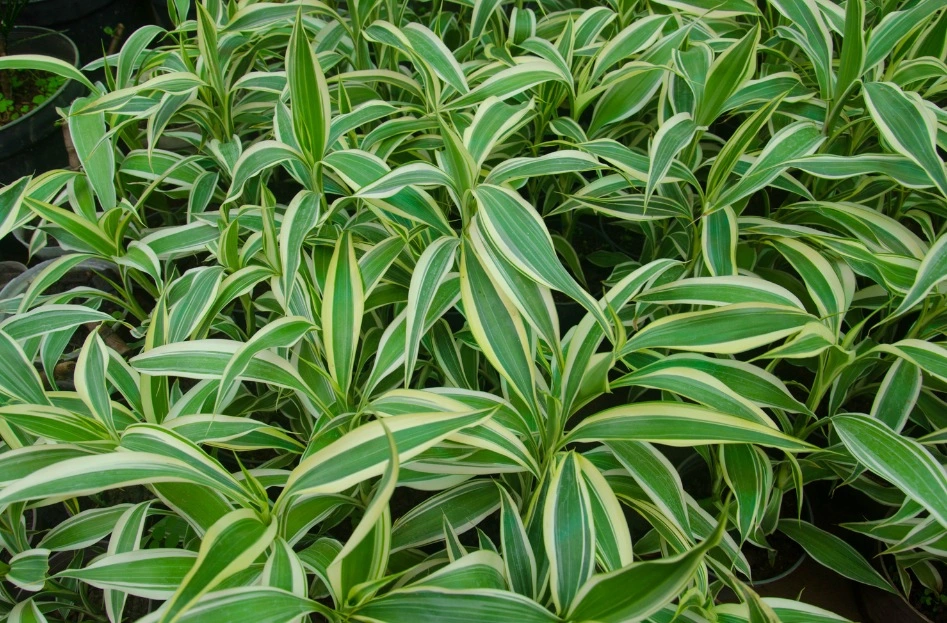
The dracaena Warneckii (Dracaena deremensis) Dracaena Warneckii is a decorative and easy-care plant. It is ideal for cultivation for novice gardeners and busy people. Dracaena produces pointed leaves that resemble a sword. The center of the leaves is dark green, while the edges are decorated with two lighter stripes. Dracena Warneckii prefers rooms with diffused light, which is why it is ideal for bathrooms, especially with bright, indirect light.
-
China doll plant

China doll plant (Radermachera sinica) The china doll plants are often grown as great bathroom plants because of their abundant, glossy green foliage. This fast-growing plant tolerates very well-growing conditions in the bathroom environment. Though it prefers bright indirect light, it can do well in the shade or artificial lighting. The china doll plant loves humidity air but doesn't like quick temperature changes. The ideal place will be a small bathroom window. You can also place china doll plants in the back of a sunny room.
This beautiful bathroom plant adds serenity to damp rooms with its intense green foliage. It is a plant with low requirements and will work well even for beginner plant fans. But remember that china doll doesn't like tobacco smoke.
-
Asparagus fern
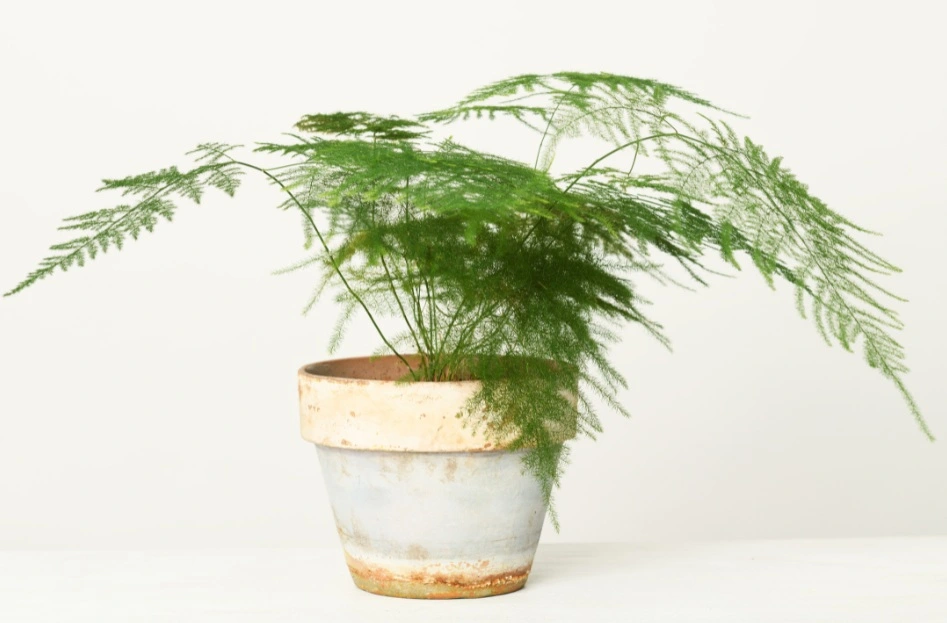
Asparagus fern (Asparagus setaceus) Asparagus fern is a beautiful, easy-to-grow, and extremely hardy plant. Delicate and intensely green leaves of asparagus are often used as ornamental plants with hanging shoots.
Asparagus fern prefers positions with a lot of diffused sunlight. It also tolerates shady places, but better lighting guarantees intense coloration and faster plant growth. Too strong direct sunlight causes yellowing, drying, and falling off. It feels good in cool and well-ventilated rooms.
Asparagus fern likes high humidity and daily spraying (especially during the heating season). For this reason, it is a perfect potted plant for the bathroom, as long as it is a bright bathroom with a window.
Recommended varieties of the asparagus fern Variety name Appearance Nanus Dwarf variety -
Dieffenbachia
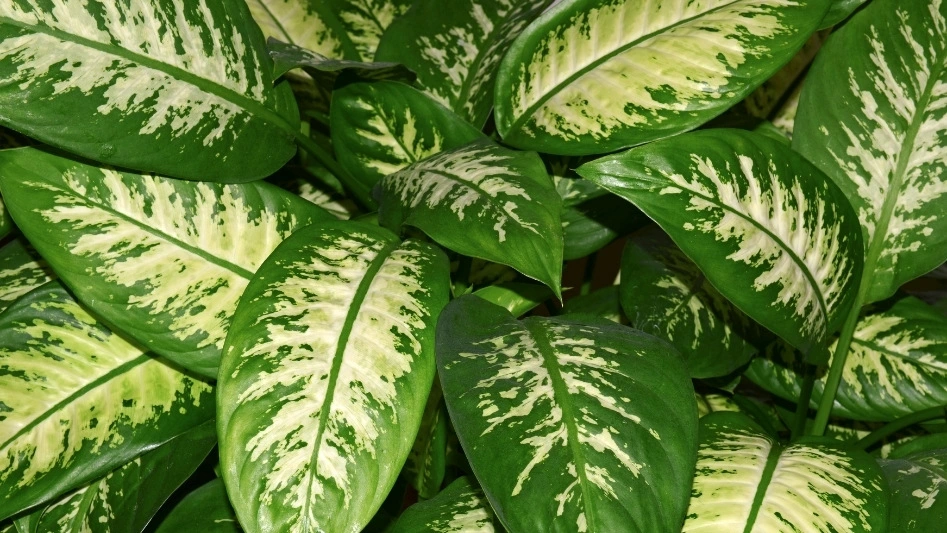
Dieffenbachia Dieffenbachia is a thermophilic plant that occurs naturally in tropical America. In container cultivation, it grows up to 120 cm. Dieffenbachia loves warm temperatures and natural, bright light with highly humid air. Therefore, grown indoors should have similar conditions. A frequent sprinkling of the plant with water will certainly help.
Dieffenbachia juice is highly toxic to humans and animals. Dieffenbachia is a hardy plant. Too wet a substrate causes rotting of dieffenbachia roots, while drying of the root ball and too dry air favors dieffenbachia leaves.
Recommended varieties of dieffenbachia Variety name Appearance Reflector With green leaves with a white mosaic pattern Camouflage With almost completely yellow leaves with a mosaic of green dots Green magic With intensely green leaves -
Croton
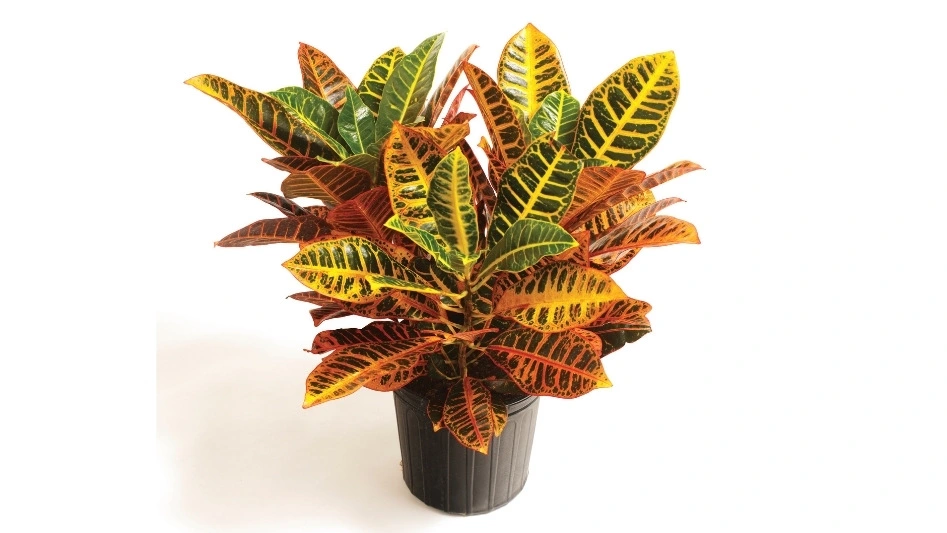
Croton The croton is a beautiful houseplant that can enliven the gloomiest room with the color and beauty of its leaves. The croton grows naturally in the Pacific islands and can also be found in Australia. As a houseplant, it grows up to 1 meter in height.
The main decoration of the plant is multi-colored leaves. From the damaged tissues of the croton, white milky juice flows out, which can irritate the skin. Too dry air causes croton leaves to fall. When the croton leaves become faded and lose their color, it is a sign that the plant needs more sun exposure. In turn, excessive watering of the plant results in sagging and falling leaves.
Recommended varieties of croton Variety name Appearance Golden bell Produces long and narrow leaves, with a yellow to red strip running along the length of the leaf Bravo Leaves slightly lobed with yellow streaks Craigii Palm-lobed leaves with yellow streaks Aucubaefolia Lanceolate leaves with yellow streaks -
Bird's nest fern
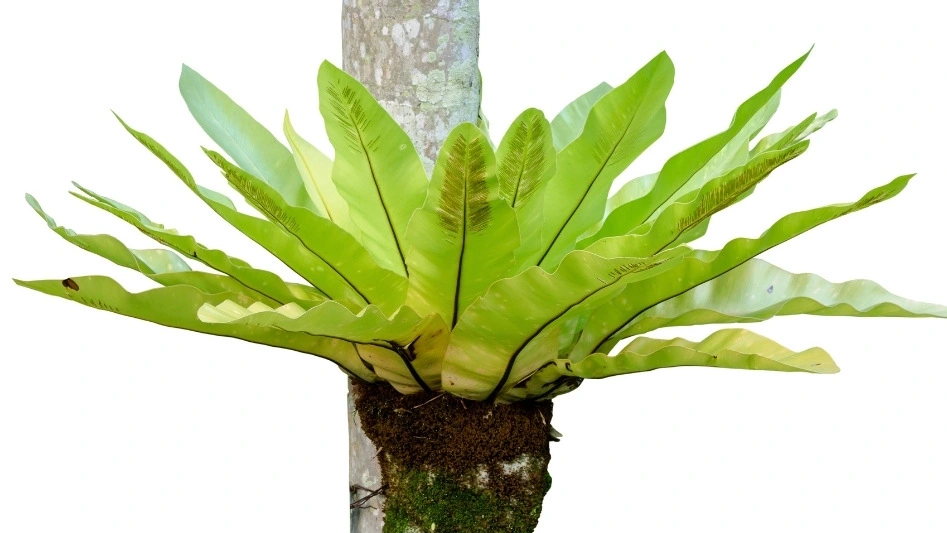
Bird's nest fern (Asplenium nidus) Bird's nest fern occurs naturally in tropical regions of Asia and Australia as an epiphyte. It produces a rosette of shiny, showy foliage. It is an edible plant. In Taiwan, it is grown and treated as a vegetable. We can plant it both in a pot with a substrate and on a trunk. Bird's nest fern leaves grow up to 50 cm in length. Bird's nest roots should not be allowed to dry out. Therefore, in room conditions, we should regularly sprinkle.
Too dry air causes browning of the bird's nest leaf tips. In turn, a fungus - gray mold - often appears on young leaves.
Recommended varieties of the bird's nest fern Variety name Appearance Crispy wave With full-border leaves Campio With irregularly cut leaves Crossie With numerous indents at the tips of the leaves -
Staghorn fern

Staghorn fern (Platycerium) Staghorn fern is an excellent choice for a humid bathroom. This air plant that occurs naturally in South America produces two types of green foliage: sterile and fertile. Sterile leaves, adhering to the substrate, protect the roots against unfavorable environmental factors. The fertile leaves are antler-shaped, hence the common name of the plant - staghorn. Those air plants do not require a substrate to grow correctly. Staghorn ferns are usually planted on a large bark or a stump.
The plant is placed on the wood, and a layer of a light epiphyte mix is applied to keep its roots moist.
Browning of the leaves of staghorn fern is caused by no high humidity. Staghorn fern does not tolerate touch, because it is easy to remove the layer of hairs from the plant, which draws air moisture and protects the plant against sun exposure.
Recommended varieties of the staghorn fern Queen Wilhelmina -
Fiddle-leaf fig

The fiddle-leaf fig (Ficus lyrata) Fiddle-leaf fig is another plant for a bright bathroom that prefers indirect light but in large quantities. The less light, the smaller the ficus leaves become. If the fiddle-leaf fig sheds the lower leaves, it can grow in a room with too little light.
Fiddle-leaf fig comes from tropical forests, like spraying and high humidity. Fiddle-leaf fig prefers to avoid rearranging and drafts. It is also very sensitive to overflow, so we only water the plant when the soil in the pot is slightly dry. The plant is best placed on the bathroom window sill where bright, indirect light is.
Recommended varieties of the fiddle-leaf-fig Variety name Appearance Bambino Grows up to 150 cm (5') -
Parlor palm
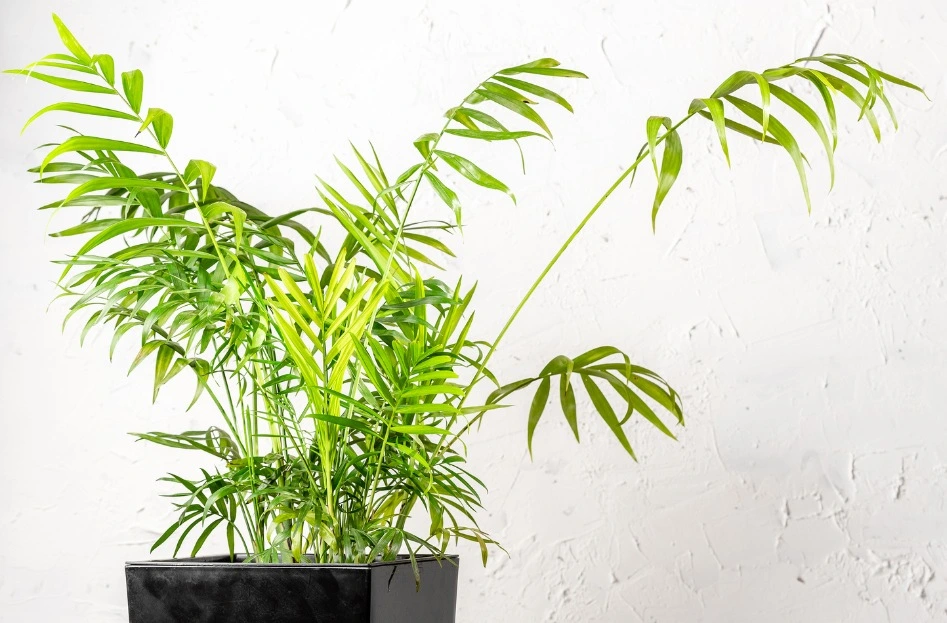
The parlor palm (Chamaedorea elegans) The Parlor palm is a perfect bathroom plant because it not only looks great in the bathroom but also thrives in those conditions. It is partly due to its preference for humidity; bathroom plants often require this moist and cozy atmosphere, which happens naturally when many showers occur. Also, Parlor palms survive well without direct light, so bathroom settings are perfect for them.
Growing parlor palm requires a well-draining potting mix that will drain excess water from the substrate. The most suitable position for the parlor palm will be where the morning is in direct sunlight.
-
Kentia palm
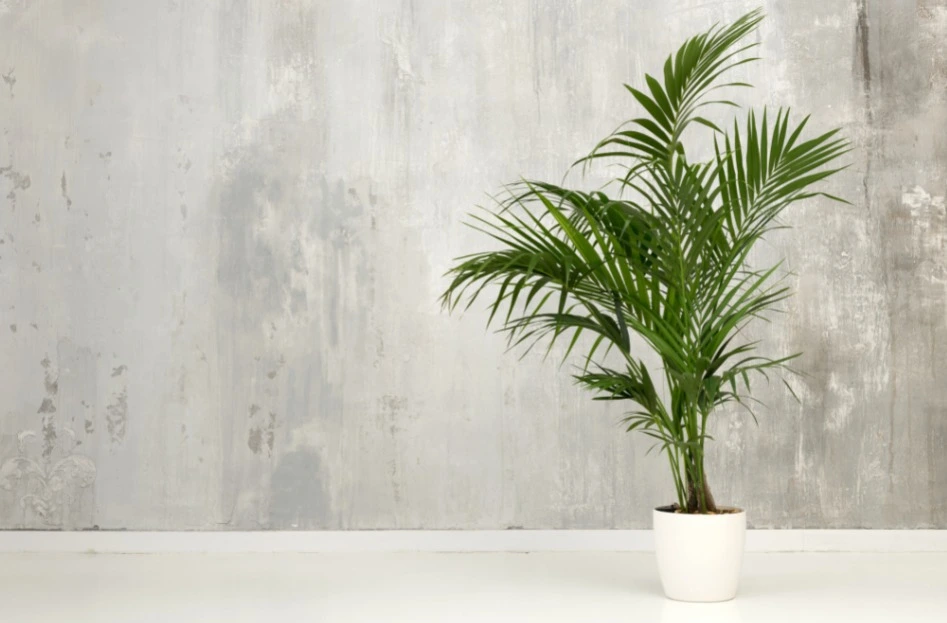
Kentia palm (Howea forsteriana) The kentia palm can make a great bathroom plant for several reasons. It thrives in humid environments, so that that bathroom humidity won't be too much for it. Furthermore, its relatively slow growth rate requires minimal maintenance and trimming compared to other bathroom plants.
Moreover, the kentia palm provides an elegant natural touch to the bathroom, which creates a peaceful atmosphere to relax. That said, this lovely bathroom plant will remain small and take up barely any space. Kentia palm makes it easy to keep a clean and aesthetically pleasing bathroom without wasting too much space or energy.
-
Chinese evergreen

The Chinese evergreen (Aglaonema) An attractive plant for the bathroom is the Chinese evergreen. Chinese evergreen prefers direct light, warm air, and light irrigation. However, too much water in the substrate contributes to root rot.
New varieties of Chinese evergreen are constantly emerging, with motley leaves and excellent resistance to dry air. As a tropical plant, Chinese evergreen does well in the conditions of bright, indirect light in the bathroom.
Recommended varieties of the Chinese evergreen Variety name Appearance Pink star Leaves with pink discoloration Chamaleon bandit Leaves in shades of cream, orange, peach -
Hoya

Hoya (Hoya carnosa) Hoyas are excellent bathroom plants as their vibrant green foliage, and tough hardiness make them the perfect choice for this dimly lit environment. This plant is a beautiful addition to the bathroom due to its fast growth rate and ability to purify the air by eliminating formaldehyde, xylene, benzene, and other toxins that can quickly accumulate with the regular use of bathroom products. Hoyas are low-maintenance plants, even in less favorable bathroom conditions.
What's more, hoya makes a stunning decorative element with its long pendula growing on any surface imaginable and its lovely flowers with a creamy scent that can add a delightful touch of natural beauty to any bathroom. Hoya is considered a reliable bathroom plant with an impressive appearance and air-purifying effect.
Recommended varieties of hoya Variety name Appearance Exotica Variegated foliage: pink and white discoloration on older leaves Argentea princess Cream drawings on leaves -
Rubber plant

The rubber plant (Ficus elastica) The rubber plant is an evergreen shrub with large green leaves native to tropical regions. Its large leaves can absorb excess moisture from the air, making it an excellent choice for bathrooms exposed to high humidity and bright light. They are ideal bathroom plants as they thrive in a humid environment.
Rubber plant is an excellent choice for interior decoration due to its glossy, deep green leaves that remain full and vibrant even in low light. It is also considered easy to maintain, making it a great plant for busy people. The rubber plant can be cut and molded into various shapes to add even more decoration, further enhancing its decorative appearance.
-
Peace lily

The peace lily plant (Spathiphyllum) A peace lily is a decorative plant that cleans the air of toxins. It will work well as an attractive, lively, and valuable element of bathroom decor. It will cope well with lower lighting. Peace lily also hates drafts and fumes from gas appliances, and the bathroom provides comfortable conditions. Peace lilies will also work very well as a bedroom plant.
The peace lily is an easy plant to grow. It loves moist air, so frequent spraying is necessary for it to bloom beautifully. The plant prefers bright light but not direct sunlight. Peace lily constantly loves slightly moist soil with a slight acid reaction.
-
Monstera plant
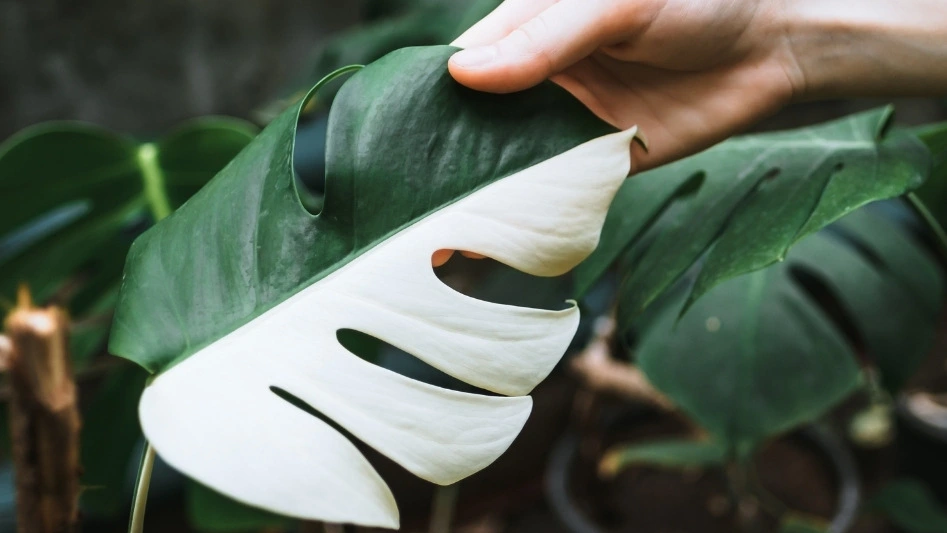
Monstera (Monstera deliciosa) Monstera is considered one of the best plants for indoor spaces. It is an evergreen semi-epiphyte that occurs naturally in tropical forests from Mexico to Panama. In its natural environment, it grows up to 10 m in height, and when grown in containers, up to 3 m in height, making it one of the largest species of houseplants.
Monsteras are very easy-to-grow tropical plants. It can handle bathroom conditions very well. One of the limitations of its cultivation is the temperature below 15 degrees Celsius. Monstera loves direct sunlight but will grow well in a low-light bathroom.
Yellowing monstera leaves are caused by too high warm temperatures or high direct sunlight. Monstera loves regular watering. Lack of water causes yellow spots on the deep green leaves.
Recommended varieties of the monstera plant Variety name Appearance Variegata With green-white leaves Thai constellation With green-white leaves -
Lucky bamboo plant

Lucky bamboo plant (Dracaena sanderiana) Dracaena sanderiana is incorrectly called lucky bamboo, but it is associated with that name. It has been present in Chinese culture for over 4,000 years. Mainly due to the habit. Due to its low requirements, it is recommended for growing in rooms with specific conditions. The lucky bamboo plant can grow in water alone. Before planting into the soil, it should be well rooted. Lucky bamboo likes high air humidity and consistently moist soil. It grows up to 150 cm in height.
Sunburn occurs on a lucky bamboo plant set in direct light. When the air is too dry, the tips of the lucky bamboo leaves turn brown.
Recommended varieties of the lucky bamboo plant Variety name Appearance Gold With light green leaves White With light green leaves with a white border -
ZZ plant
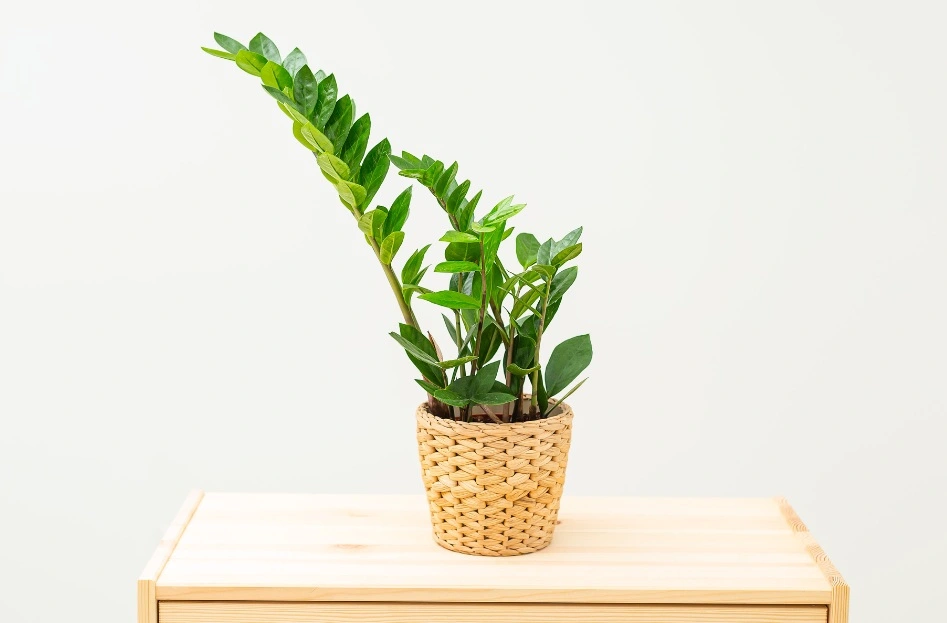
ZZ plant (Zamioculcas zamiifolia) ZZ plant is the best plant for a windowless bathroom. Although every plant needs sunlight to live, the ZZ plant will develop well thanks to proper care, even in a bathroom without a window.
ZZ plants are resistant to adverse conditions. It is a plant resistant to drought, lack of sunlight, and pests, which is why it is often called the iron plant. The plant does not need a lot of light, it even likes semi-shaded positions, and direct light causes brown spots on the plant's leaves. The easiest and surest way to grow plants in a windowless room is to have two plants alternately placed in a dark room and a bright one without direct light.
We can replace plants weekly. Thanks to the thick rhizomes, zamiocucas can accumulate water, so we only water it when the pot's soil is slightly dry.
Recommended varieties of the ZZ plant Variety name Appearance Zenzi A compact plant habit Dovon Dark, almost black leaves -
Chinese money plant

Chinese money plant (Pilea peperomioides) Pilea peperomioides is popularly known as a Chinese money plant. This plant was often found on window sills in the 80s or 90s, and today it is again willingly grown in homes since the Chinese money plant comes from the tropics, so it likes bright light but with diffused indirect light. Chinese money plants grow well in humid environments, which is why they are typical bathroom plants.
Healthy Chinese money plants produce number of glossy leaves and even some baby plants around the base.
-
Boston fern
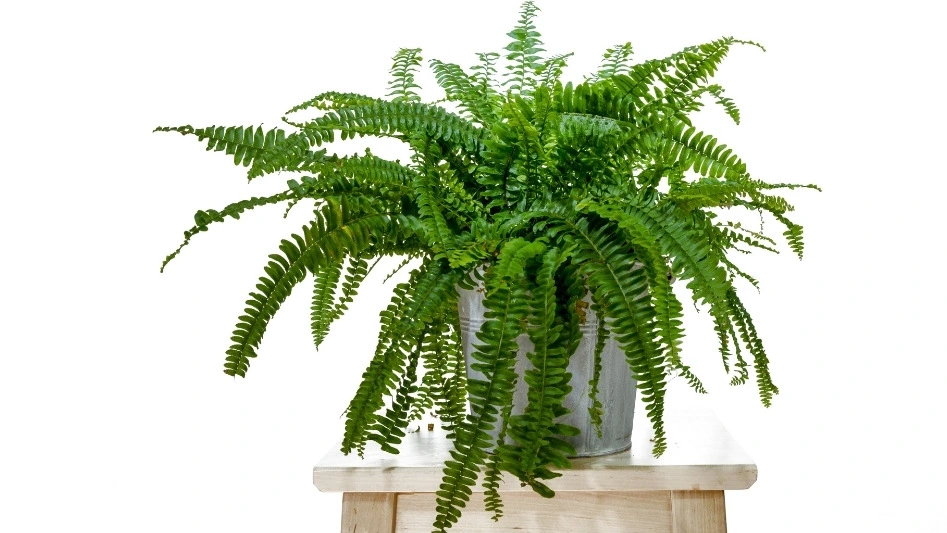
Boston fern (Nephrolepis exaltata) Boston ferns are excellent air-cleaning plants. Its popularity is due, among other things, to the ease of cultivation. Boston fern comes from the northern regions of South America. In countries with warm climates, it grows as an ornamental garden plant with green foliage. Boston ferns are humidity-loving plants that are tolerant of medium soil moisture.
Boston fern was very popular in the Victorian era. Currently, it is experiencing a renaissance in its popularity. Due to its long, falling leaves, it is ideal for growing in hanging baskets and pots. Boston fern is a disease and pest-resistant plant. Boston fern prefers low-light exhibitions and loves humid environments. Usually, the browning of fern leaves is caused by a not enough humid room. It is why Boston ferns are recommended for humid environments as bathroom plants.
Recommended varieties of the boston fern Variety name Appearance Plumosa With dark and glossy leaves Roosveltii With crimped leaves Hillii With narrow and double pinnate leaves Smithi With exceptionally delicate, four-pinnate leaves -
Aloe vera

Aloe vera (Aloe Barbadensis) Another one of the best bathroom plants is aloe vera. Aloe vera is a succulent plant. Thanks to this, it has little watering and humidity requirements. Its characteristic feature is numerous health-promoting properties - the juice is commonly used in medicine and cosmetics. Like every flower, aloe vera needs sunlight to live, so it is worth artificially lighting it.
-
Spider plant
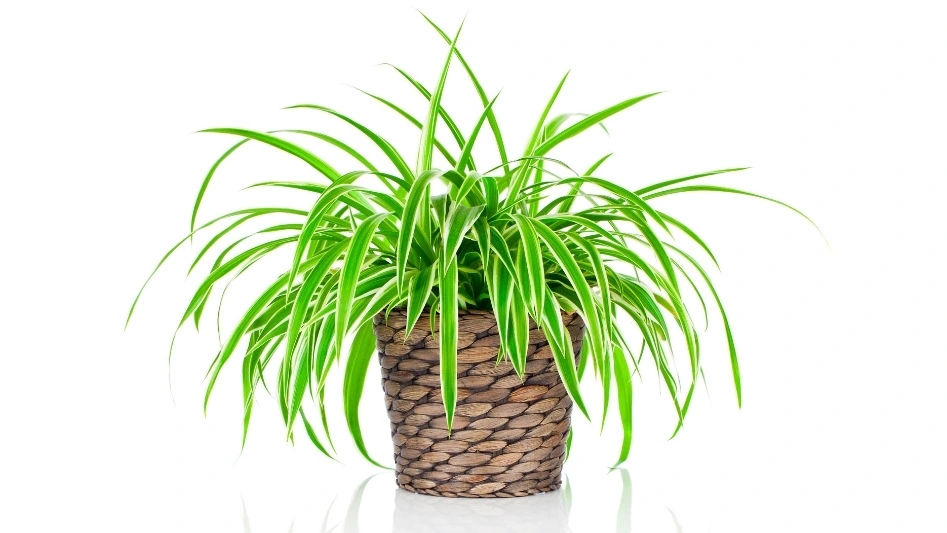
Spider plant (Chlorophytum comosum) The spider plant is a perennial evergreen herb. The spider plants will always repay you with a beautiful habit, no matter where you place it, in a heated or cool room, in the sun, or in the shade.
It constantly produces new generations in the form of baby spider plants on long shoots up to 100 cm in length. This South African plant blooms with inconspicuous white flowers set on long stems amid rosettes formed by leaves. It is an excellent plant for rooms with low light.
Spider plants are low-maintenance plants. The brown ends of the leaves of the spider plants are formed due to insufficient air humidity. If the plant is sick, it is usually because the roots have rotted in water.
Recommended varieties of the spider plant Variety name Appearance Variegata With striped green-white leaves Bonnie With striped yellow-green leaves Vittatum Gray-green leaves with a white stripe in the center Ocean White-edged, light green leaves -
Snake plant
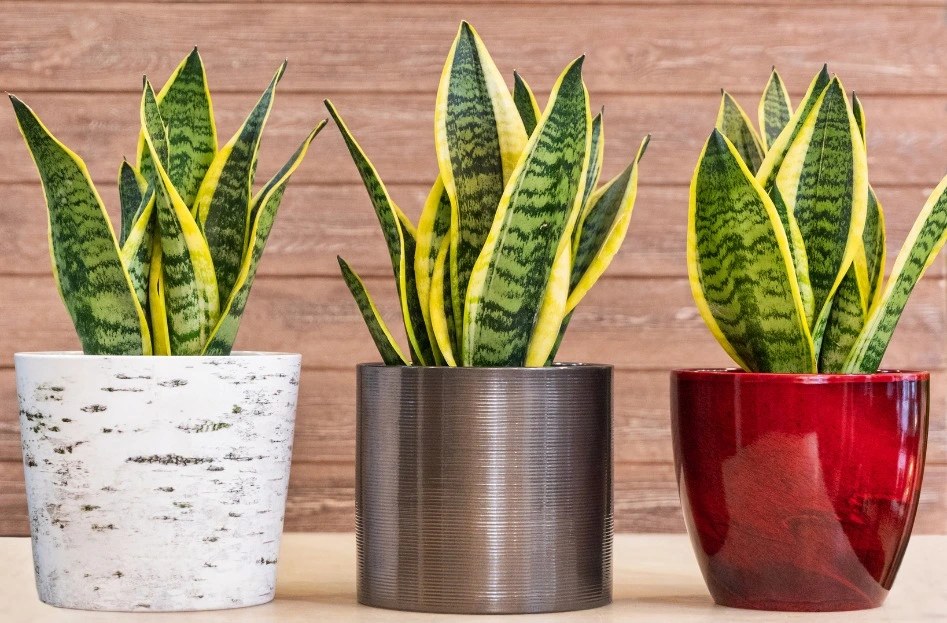
Snake plant (Dracaena trifasciata) Snake plants are undemanding bathroom plants commonly known as mother-in-law's tongues. It is a tropical plant and leaf succulent. They have a soaring habit and grow slowly. The snake plant forms a rosette of fleshy, long saber-like leaves. Snake plants produce dark green foliage with a lighter striped pattern and light green edges. Snake plants are elegant plants for modern interiors.
We can water snake plants only sometimes. Snake plants feel best in a warm room. They can stand near a heating radiator. It grows well in full and medium light but tolerates low light.
Snake plants grow best in a humid environment. No high humidity causes the leaves to turn brown. That is why the snake plant is ideal for a humid bathroom. Snake plant loves regular watering but only sometimes. Too much water in a pot can kill this exotic plant. Snake plant also tolerates low light space.
-
Golden pothos
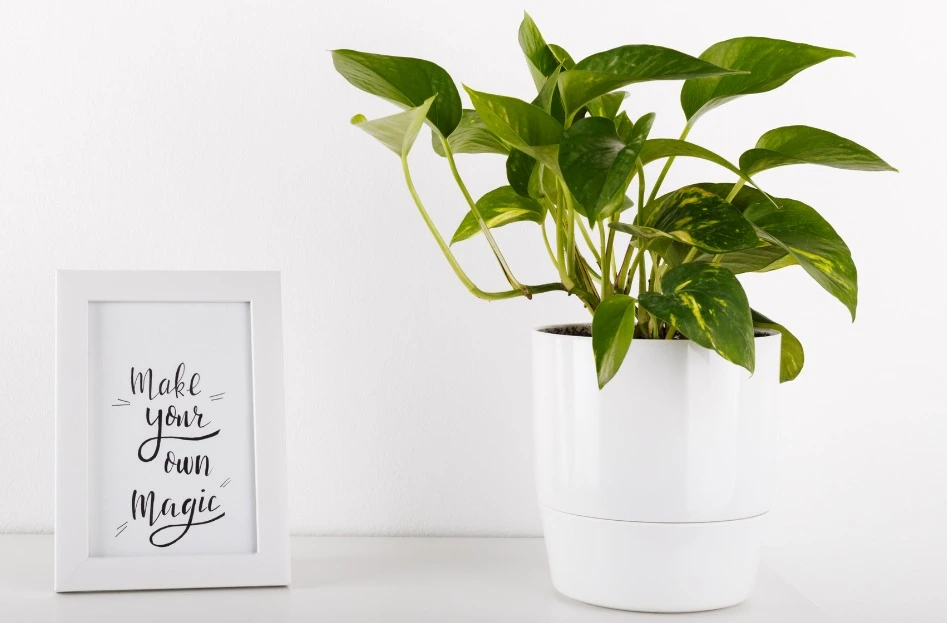
Golden pothos (Epipremnum aureum) Golden pothos likes moderate to bright indirect light, making it an ideal plant to display on a bathroom shelf. Pothos are great for the bathroom as they tolerate low light levels and irregular watering.
Golden pothos is easy to care for. It is a vine that grows quickly and can be placed on a bathroom shelf or suspended from the ceiling. It is resistant to black thumbs.
-
Air plant
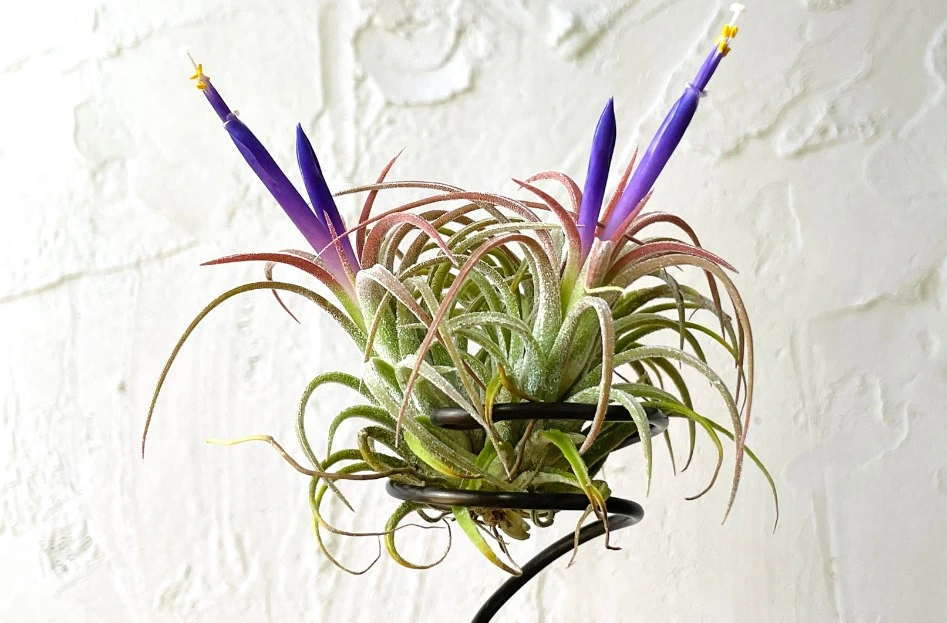
Air plant (Tillandsia ionantha) Air plants are one of the best bathroom plants. Air plants are great for the bathroom as they can absorb moisture directly from the shower. In addition, air plants do not need pots because they can grow without soil. It's one of the best bathroom plants to absorb all the moisture from the air.
Air plants can tolerate many conditions but grow best in a spot with bright indirect sunlight and a humid environment. An air plant in a bathroom can improve air quality, absorb excess moisture, and give an indoor spa oasis feel. It is worth choosing air plants if you have a bathroom with a large, sun-exposure window.
Recommended varieties of the air plant Variety name Appearance Ocean>Aurea Yellow leaves Ocean>Rubra Slight red discoloration on upper leaves -
Moth orchid

Moth orchid (Phalaenopsis) Moth orchids are the best bathroom plants. Phalaenopsis prefer a high-humidity environment. Most orchids love bright indirect light and high humidity (up to 80%), so the conditions in a humid bathroom will be perfect for them. Orchids do not tolerate flooding of the roots, so they require watering after they are completely dry.
Moth orchids come from tropical regions with high humidity and indirect sunlight. Although at home, we grow them in pots filled with a unique substrate. Orchids do not like wet soil. Too much water in the soil is the cause of rooting roots. In nature, Phalaenopsis usually grow as epiphytic orchids. You can hang them on the bathroom wall. Moth orchid is also one of the best hypoallergenic flowers for allergy sufferers. The pollen it produces is not volatile, thus minimizing the risk of allergies.
Summary
It cannot be unequivocally said that in every bathroom it is possible to grow a specific species. If you have a warm, bright bathroom with high relative humidity, growing ferns will do the job. For more shaded places, lucky bamboo can certainly be recommended. A bright bathroom is an ideal place for plants.
However, there are rooms completely without windows. Unfortunately, if you want to grow flowers in such a room, you must know that every plant needs sunlight to live. Therefore, you will either have to expose the plants growing there to a bright room at least once a week, or invest in lamps that emit sunlight.


